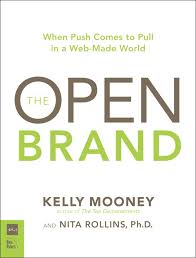
I just finished reading “The Open Brand” by Kelly Mooney and Nina Rollins.” In it, the authors describe how the one-way-push style of marketing typical to Web 1.0 is giving way to a two-way communication style of marketing in Web 2.0. Just as the transition from Web 1.0 to Web 2.0 technology is physically enabling a “read-write Web,” it is also enabling a whole new communication style with customers that will create a more engaged relationship with greater brand affinity and loyalty.
The authors argue the need for an O.P.E.N. brand strategy:
On-demand. Always open for business.
Personal. Remember your customer preferences and treat them as individuals.
Engaging. Build an immersive, participatory, and relevant dialogue with customers.
Networked. Open brands are active participants in the social network.
The book goes on to argue that brands should not only listen and have two-ways conversations with customers but that they should loosen their control of brands, letting customers participate in brand positioning, have direct input to brand messaging, and influence product definition.
This all probably sounds slightly radical and it is easy to say that it only applies the the B2C consumer world. Enterprise B2B companies are much more used to carefully controlling their brands and messaging. After all, “we’re the experts on these technologies, aren’t we?” This is a very dangerous state of mind indeed.
Web 2.0 is enabling the type of customer relationships that customers have wanted all along:
- Customers want to be asked their opinion.
- Customers want to be able to get the advice of respected peers
- Customers want to hear from peers “who have actually done it.”
- Customers are literally dying to provide product feedback and suggestions.
- Customers want to be able to communicate in many media, print, online, voice, video.
- Customers don’t want “drive-by selling,” they want a relationship with the vendor.
- Finally, as travel budgets and time become more scarce, customers want to be able to participate and find information on-demand.
These trend are happening in both B2B and B2C. The companies who understand what their customers want, provide an engaging brand experience and truly listen will have a serious leg up on their competition.
A number of executives resist Social Media due to negative public relations events such as the “United Breaks Guitars” firestorm. Remember, social media was not the cause of this event, but it could be the best way to deal with negative events like this and minimize their impact by:
- Early detection of the issue
- An honest and forthright response to the issue
- Communication of the resolution of the issue (Hopefully, somewhere before you get into the millions of YouTube views.)
The bottom line is that Social Media is happening with or without your company’s involvement. Current customers, potential customers, press and analysts are talking about your brands and products online every day. The question is: Are you going to actively participate, or are you going to let external forces position you?
I will be writing about how some Enterprise B2B companies are using Social Media in future blogs.






